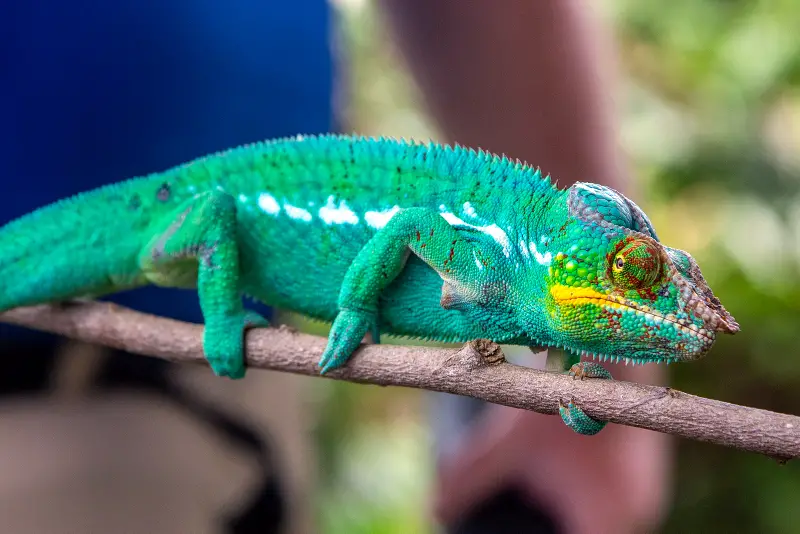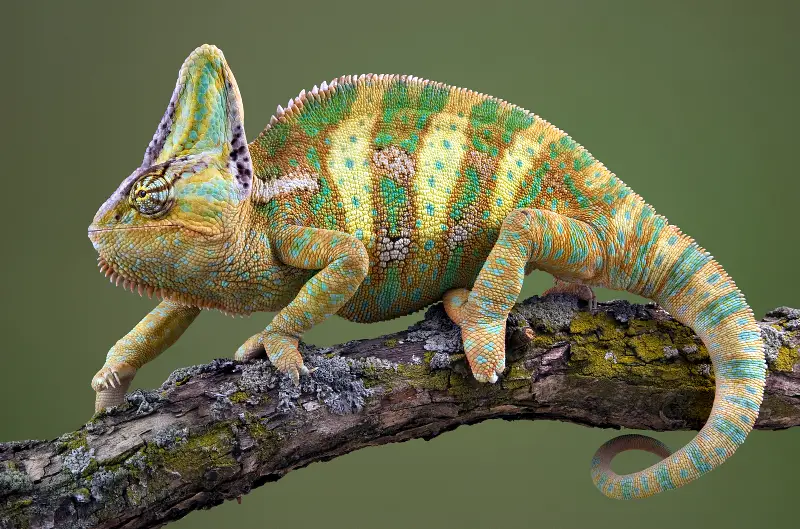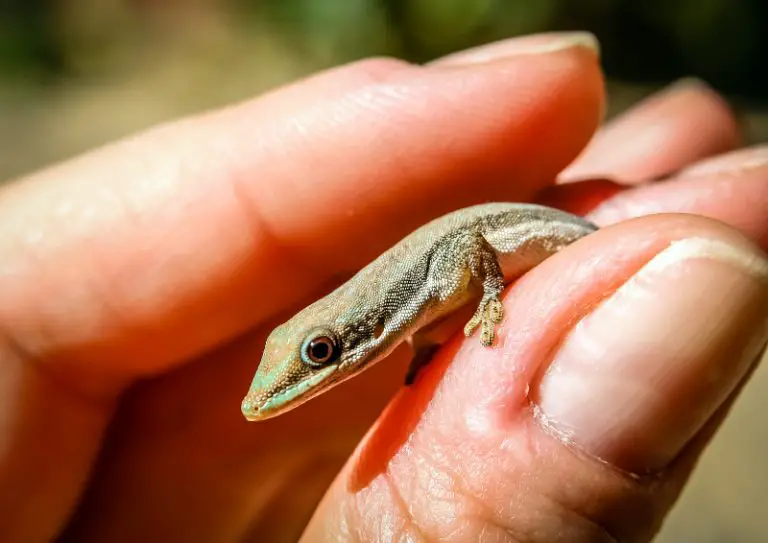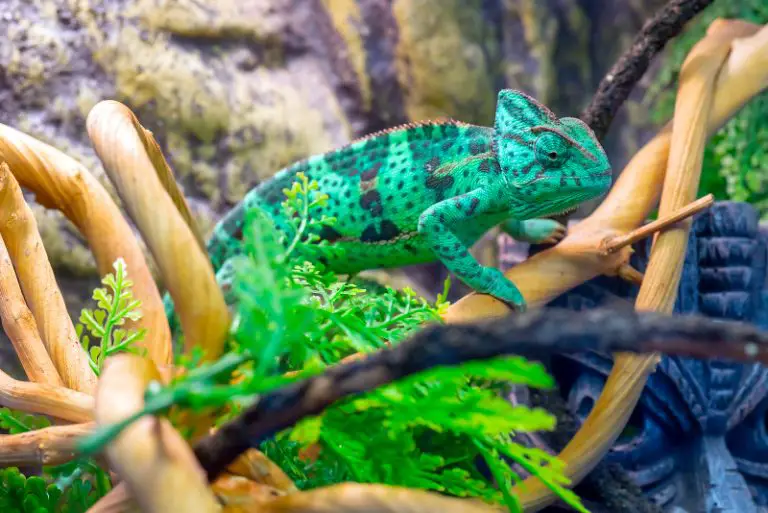Veiled Chameleon Vs Panther Chameleon: Which Is Best?

Are you thinking about bringing home a Chameleon, but you don’t know which one to get? Luckily, we’re sharing the pros and cons of two popular Chameleons. In this article, we’ll discuss what Chameleons are and what Veiled Chameleons and Panther Chameleons are specifically. Then, we’ll go over the differences and the similarities of the Veiled Chameleon Vs Panther Chameleon.

Contents
Table of Contents
What Are Chameleons?
Chameleons are part of the reptile and Iguana families, being lizards. They’re also known as Tree-Dwellings, often found climbing to high areas in the wild. In addition, Chameleons are well-known for being able to change their body color, depending on how they’re feeling.
They may be slow while walking, but they have long, sticky tongues that are fast to catch their prey and eyes that can look 360-degrees. But did you know that there are about 160 known species of Chameleon? Let’s compare and contrast two of them.
What Is A Veiled Chameleon?

First, we have the Veiled Chameleons. They are commonly found on coastal plains, mountains, and high deserts in Yemen and Saudi Arabia.
What’s unique about this type of Chameleon is that they have a veil on top of its head, which helps them survive the harsh hot weather of these climates.
In addition to staying cool, dew drops can collect on the veil and trickle down to the mouth and hydrate them.
What Is A Panther Chameleon?

Next, we have the Panther Chameleon. They are commonly found in the northern and coastal areas of Madagascar. They’re often found in bushes and trees and the coastal lowlands where it’s warm and humid.
What’s special about this type of Chameleon is that they are the most colorful Chameleon out of all the species.
So, let’s look at both of these types of Chameleons.
Veiled Chameleon Vs Panther Chameleon
Believe it or not, Veiled Chameleons and Panther Chameleons have more similarities than you’d think. In fact, their differences are only slight when it comes to certain things, such as size and weight.
So, let’s take a closer look at the Panther Chameleon vs. Veiled Chameleon.
Appearance
First, let’s talk about what the Veiled Chameleon looks like compared to the Panther Chameleon.
Length
When it comes to their sizing, Veiled Chameleons are a little bit bigger than Panther Chameleons. For instance, out of all the different species of Chameleon, Veiled Chameleons are known to be the largest.
For both of these particular species, males are typically longer than females.
For example, male Veiled Chameleons can grow up to 24 inches long, while male Panther Chameleons can grow up to 21 inches long.
On the other hand, female Veiled Chameleon can grow as long as 14 inches while female Panther Chameleons are expected to grow about 13 inches long.
Weight
The species and the two genders also weigh different amounts. Once again, males are typically heavier than females.
For instance, male Veiled Chameleons weigh about 4.2 to 8.8 ounces, and male Panther Chameleons weigh about 4.9 to 6.3 ounces.
Female Veiled Chameleons weigh about 2.9 to 6.3 ounces, and female Panther Chameleons are known to weigh about 2.1 to 3.5 ounces.
Coloration
Finally, they both look different in their overall appearance. For instance, they have different body colors.
Veiled Chameleons typically sport a bright green color. When they become sick, their color will grow darker. Also, they can change their coloring based on if they’re hunting on hiding. Veiled Chameleons can camouflage, blending in with their surroundings, such as bushes and trees.
Panther Chameleons are more vibrant with their coloring. They can come in bright emerald green, blue-green, or turquoise.
In other words, based on their coloring alone, you’ll easily be able to tell a Veiled Chameleon from a Panther Chameleon.
Watch this Veiled Chameleon Vs Panther Chameleon: Which Is Best? video:
Activity And Personality
These Chameleons are diurnal, which means they’re both the most active during the day. At night, when you turn off their lights, they’ll both know it’s time for bed and sleep through the night.
In fact, Veiled Chameleons will sleep for a full 12 hours at night.
Speaking of sleep, even though these Chameleons are cold-blooded, neither one of them brumate (or hibernate). Of course, during the colder months, they might lose their appetites and eat less, but this is normal.
If you notice that your Panther Chameleon is trying to hibernate, then this is a sign they’re sick. You’ll want to bring them to the vet immediately.
When it comes to their personality, they’re both shy, and they’re both aggressive. Veiled Chameleons and Panther Chameleons can become stressed easily and are both territorial. So, they may show aggression if they see their reflection or if they’re not quite used to you.
Veiled Chameleons are more aggressive, hissing, and sometimes biting. Panther Chameleons haven’t been known to do that, but they’ll show other sides or simply hideaway.
Neither of them likes being handled or held. But, like babies or juveniles, you can gently handle them once in a while. Over time, they’ll get used to it. So, as adults, if you have to handle them, they won’t be as stressed out about it.
With that said, Panther Chameleons are more patient than Veiled Chameleons. They’re also more intelligent, learning your schedule and routine.
So, if you’re torn between which Chameleon to get for yourself or your kids, a Panther Chameleon will be more friendly and easier to tame than a Veiled Chameleon.
Lifespan And Overall Health
Which one lives longer? The Veiled or Panther Chameleon? With proper care through nutrition, excellent habitat, and exercise, both of these Chameleons can live up to seven years.
However, the Panther Chameleon can live shorter than the Veiled Chameleon. For instance, the minimum number of years a Veiled Chameleon is likely to live is about five years. In comparison, the minimum number of years for a Panther Chameleon is about three years.
Luckily, both Chameleons are hardy and are relatively healthy. So if cared for properly, you won’t see any health issues with them.
However, both of them are prone to the following:
- Metabolic Bone Disease
- Calcium Deficiency
- Vitamin D Deficiency
In addition, Veiled Chameleons are known to get respiratory issues, and Panther Chameleons are also known to have liver problems.
Habitat Needs
Both of these Chameleons need a similar setup when it comes to their habitat. For example, they need warm temperatures, ample space to climb, and plenty of ventilation.
Regardless of which Chameleon you adopt, you need an enclosure that’s screen-sided. Plastic and glass tanks won’t do since they need ventilation from all sides. (Also, you’ll find that Chameleons love to climb along the sides and top.)
The cage should be at least 24 x 24 x 48 inches, so they have plenty of room to climb and roam.
They both need lighting and heat during the day, with a hot basking area. They won’t need light at night but will still need the temperatures to be somewhat warm.
Inside their terrariums, they should have plenty of decor to help them hide in caves, but most importantly, to climb on. For example, artificial vines and branches will allow them to climb and look authentic to the wild.
Diet
Finally, their dieting needs are different from one another. Veiled Chameleons eat a more varied diet than Panther Chameleons.
For example, they can eat insects and dark leafy greens. They may also eat vegetables and fruits as well.
Read more about the Veiled Chameleon’s diet here.
On the other hand, Panther Chameleons are known only to eat insects. So they’re insectivores, only having insects as their diet.
What Is The Main Difference Between Veiled And Panther Chameleon?
There are a few differences between the Veiled Chameleon and the Panthera Chameleon. So, which one is the right pet for you?
Take a look at the table below to see the differences (and some similarities) laid out.
| Veiled Chameleon | Panther Chameleon | |
| Lifespan | Five to seven years | Three to seven years |
| Weight | Males are 4.2 to 8.8 ounces, and females are 2.9 to 6.3 ounces | Males are 4.9 to 6.3 ounces, and females are 2.1 to 3.5 ounces |
| Size | Males can grow up to 24 inches long, and females can grow up to 14 inches long | Males can grow up to 21 inches long, and females can grow up to 13 inches long |
| Coloration | Light green with a light pattern on their side will become a darker green when sick | The body can be bright emerald green, blue-green, or turquoise |
| Activity | Diurnal – will sleep 12 hours every night when UVB light is turned off | Diurnal – will sleep well when UVB light is turned off |
| Diet | Insects and dark leafy greens | Insects only |
| Brumation | Does not hibernate but may lose appetite in colder months | Does not hibernate, but might try to if they’re sick (bring them to the vet if this occurs) |
| Personality | Shy and aggressive, but can be tamed to get used to you | Shy and friendly, easier to tame, and intelligent, quickly learning your schedule |
| Aggression | Territorial and does not like being handled and may hiss and bite when stressed | Territorial and does not like being handled, but may not show as many aggression signs |
| Handling | Does not like being held | Does not like being held |
| Enclosure | Screen sided cage, minimum of 24 x 24 x 48 inches | Screen sided cage, minimum of 24 x 24 x 48 inches |
| Lighting and Heating | The base should be 68 degrees F, the middle should be 86 degrees F, and the basking area should be 95 to 104 degrees F | Day temperature should be about 75 to 78 degrees F, night temperature should be about 68 to 71 degrees F, and basking area should be more than 86 degrees F |
| Health | Relatively healthy but prone to respiratory illness, calcium deficiency, vitamin D deficiency, and metabolic bone disease | Relatively healthy but prone to liver problems and metabolic bone disease |
| Good Beginner Pet | Yes | Yes |
| Availability | Can be found at local pet stores | Can be found at local pet stores or reputable breeders |
Conclusion
Learning the differences and similarities between the Veiled vs. Panther Chameleon isn’t as hard as you’d think. They have quite a few differences but are similar overall. There’s a lot to love about the Veiled Chameleon and the Panther Chameleon.
Learn more about Chameleons here or click here to learn what Chameleons eat.





![How Big Do Veiled Chameleons Get? [Must Read]](https://allourcreatures.com/wp-content/uploads/2021/12/Veiled-Chameleon-001-768x513.jpg)
![What Do Veiled Chameleons Eat? [Full Guide]](https://allourcreatures.com/wp-content/uploads/2021/12/veiled-chameleon-eating-768x512.jpg)
![Do Chameleons Smell Bad? [Smell Guide]](https://allourcreatures.com/wp-content/uploads/2021/12/veiled-chameleon-aquarium-768x513.jpg)